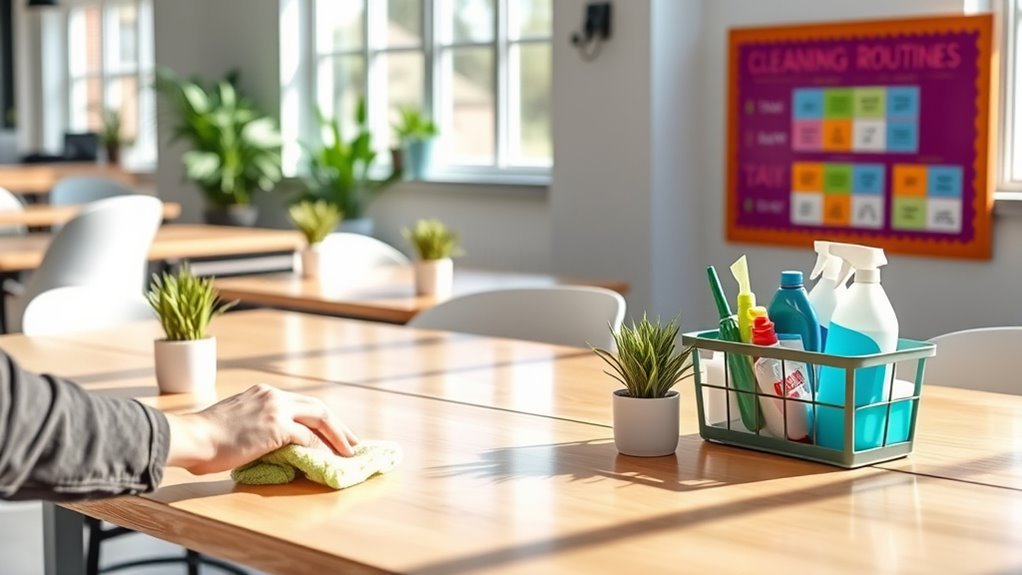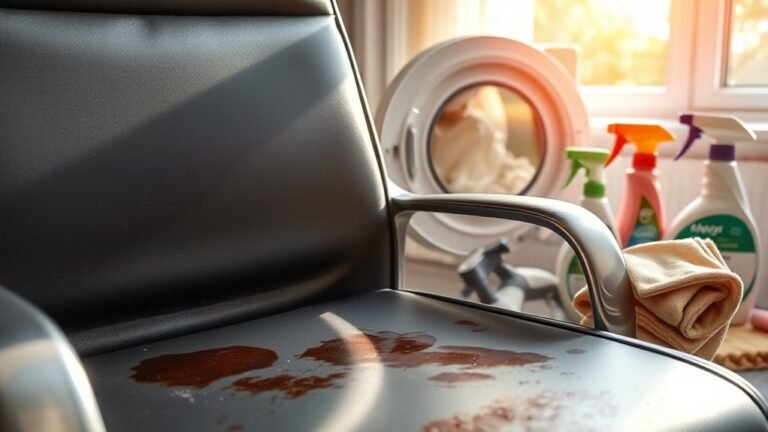Cleaning Hacks for Shared Workspaces and Coworking Areas
To keep shared workspaces fresh, try simple daily routines like wiping desks and tidying common areas. Use microfiber cloths and alcohol-based wipes to disinfect shared devices regularly. Organize personal items with labeled bins and create communal supply zones to maintain order. Manage trash with clear recycling bins and educate everyone on proper waste separation. Encouraging respect and teamwork builds a positive culture, making the space pleasant for all. You’ll find even more practical tips to maintain a tidy, healthy coworking environment ahead.
Daily Cleaning Routines to Keep Spaces Fresh

Although it might seem small, daily cleaning routines can make a big difference in keeping your workspace fresh and inviting. When you follow consistent cleaning schedules, you create an environment where everyone feels comfortable and focused. It’s not just about tidiness; it’s about respecting workspace etiquette that values shared freedom and productivity. By wiping down your desk, organizing your materials, and disposing of trash regularly, you contribute to a clutter-free zone that sparks creativity. You don’t need to spend hours—just a few minutes daily to keep things neat. This simple commitment lets you enjoy a workspace that’s both functional and welcoming, empowering you and your coworkers to work freely without distractions or mess.
Essential Cleaning Supplies for Coworking Areas
You’ll want to stock up on must-have cleaning tools like microfiber cloths and disinfectant sprays to keep coworking areas spotless. Choosing effective sanitizing products is key to tackling germs and maintaining a healthy environment. Let’s look at the essentials that make cleaning easier and more efficient.
Must-Have Cleaning Tools
Having the right cleaning tools can make maintaining a coworking space much easier and more efficient. You’ll want to invest in eco friendly options that respect the environment while keeping the area fresh. Look for biodegradable wipes and reusable microfiber cloths to reduce waste. Portable gadgets like handheld vacuum cleaners and compact steamers give you freedom to clean every nook without hassle. A lightweight spray bottle filled with natural cleaning solutions lets you tackle spills or smudges on the go. Don’t forget a sturdy duster with an extendable handle to reach high spots effortlessly. With these must-have tools, you can maintain a clean, inviting workspace that supports productivity and your desire for a sustainable, flexible environment.
Effective Sanitizing Products
Several effective sanitizing products are essential for keeping coworking areas germ-free and safe. You’ll want sanitizing sprays that quickly eliminate germs without leaving harsh residues. Look for options labeled as eco friendly cleaners; they protect your health and the planet, letting you clean freely without guilt. These products often use natural ingredients, reducing exposure to toxic chemicals while maintaining strong disinfecting power. Keep a variety handy—wipes for quick surface touch-ups and sprays for deeper sanitation. This way, you’re ready to tackle everything from shared desks to communal kitchen spots with ease. Choosing the right sanitizing products empowers you to maintain a clean, healthy workspace that matches your independent spirit and respects the environment.
Tips for Disinfecting Shared Devices and Equipment

When disinfecting shared devices and equipment, choosing the right disinfectant is key to killing germs without damaging your gear. You’ll want to clean these items regularly, especially after heavy use, to keep your workspace safe. Also, handling devices carefully during cleaning guarantees they stay functional and hygienic.
Effective Disinfectant Choices
How do you choose the right disinfectant for shared devices and equipment? You want something effective but also safe for both people and the planet. Natural disinfectants like vinegar or hydrogen peroxide offer powerful cleaning without harsh chemicals, making them excellent eco friendly solutions. They kill germs while preserving your freedom from toxic residues. Just make sure the disinfectant is compatible with electronics—avoid soaking devices and use a soft cloth for application. For quick, on-the-go cleaning, alcohol-based wipes with at least 70% isopropyl alcohol work well and dry fast without damage. Balancing efficiency with environmental care lets you maintain a healthy workspace and stay true to your values. Choosing wisely means you protect both your health and the shared environment effortlessly.
Cleaning Frequency Guidelines
Although it might seem tedious, setting a regular cleaning schedule for shared devices and equipment is essential to prevent germ buildup and keep everyone healthy. You want to maintain a balance that keeps your workspace fresh without feeling restricted. Aim to disinfect high-touch items like keyboards, mice, and phones daily, while less-used equipment can follow a weekly routine. Creating maintenance checklists helps you stay on track and guarantees nothing gets overlooked. By sticking to these cleaning schedules, you not only promote a healthier environment but also support the freedom to work comfortably and confidently. With a simple system in place, you can enjoy a clean, safe space without the hassle of last-minute scrambles or interruptions.
Safe Device Handling
Since shared devices can quickly become hotspots for germs, you’ll want to handle them with care during cleaning. Practicing good device etiquette means wiping down keyboards, mice, touchscreens, and phones regularly with disinfectant wipes that won’t damage electronics. Avoid spraying liquids directly on devices—apply them to a cloth first. Make it a habit to clean before and after use to promote safe sharing and minimize cross-contamination. Encourage others to do the same by setting clear guidelines or placing reminders nearby. By treating shared equipment with respect and following these simple steps, you protect yourself and your coworkers while maintaining a fresh, healthy workspace. Safe device handling isn’t just smart—it’s essential for freedom to work confidently in any shared environment.
Organizing Personal and Communal Workstations

When you take a few moments to organize your personal and communal workstations, you’ll find tasks flow more smoothly and stress levels drop. Start by setting up personal storage that’s easy to access yet keeps your items tidy—think stackable trays or labeled bins. This way, you control your space without clutter creeping in. For communal organization, create shared zones for supplies everyone needs, like pens, chargers, or notepads, and keep these areas neat with clearly marked containers. Encourage others to return items after use, promoting respect for the shared space. Keeping both your personal and communal workstations organized gives you the freedom to focus on what matters—your work—without distractions from disorder or misplaced tools. It’s a simple step toward a more enjoyable, efficient workspace.
Managing Trash and Recycling Efficiently
Keeping your workspace organized isn’t just about managing supplies—it also means handling trash and recycling smartly. You want to master trash separation to reduce clutter and waste. Clear labeling and accessible bins make it easy for everyone. Plus, recycling education empowers you and your coworkers to keep the environment clean without hassle. Here’s a simple guide to managing waste efficiently:
| Waste Type | Bin Color | Tips for Proper Disposal |
|---|---|---|
| Paper & Cardboard | Blue | Flatten boxes, remove staples |
| Plastics & Cans | Green | Rinse containers before tossing |
| Food Waste | Brown/Compost | Use compostable bags if possible |
| General Trash | Black | Avoid mixing recyclables here |
Stick to these steps, and you’ll enjoy a freer, tidier workspace.
Encouraging a Clean Culture Among Coworkers
Although maintaining a clean workspace is often seen as an individual responsibility, fostering a culture where everyone pitches in makes a bigger difference. You’ll find that when you openly discuss cleaning challenges with your coworkers, it creates a shared sense of accountability. Setting clear coworker responsibilities helps avoid confusion and guarantees tasks don’t fall through the cracks. Encourage simple habits like wiping down surfaces after use or tidying common areas regularly. By promoting respect for the space and each other’s freedom to work comfortably, you help build a positive environment. Remember, a clean culture isn’t about policing—it’s about collaboration. When everyone takes part willingly, your shared workspace stays inviting and efficient without sacrificing the independence you value.
Frequently Asked Questions
How Often Should Deep Cleaning Be Scheduled in Coworking Spaces?
You’ll want to set your deep cleaning frequency based on how busy your space gets and the types of activities happening there. Consider schedule considerations like peak usage times and any health guidelines. Generally, deep cleaning every one to three months works well to keep things fresh without being too disruptive. This balance lets you enjoy freedom in your workspace while maintaining a clean, inviting environment for everyone.
What Are Eco-Friendly Cleaning Product Options for Shared Offices?
If you want to keep your space fresh without harming the planet, you should opt for green cleaning products. These sustainable products use natural ingredients, cutting down on harmful chemicals and waste. You’ll feel freer knowing you’re protecting the environment while maintaining a clean office. Look for biodegradable sprays, reusable microfiber cloths, and refillable containers to reduce plastic. It’s all about choosing eco-friendly options that let you clean smarter and live lighter.
How to Handle Cleaning Responsibilities During a Coworking Space Event?
When you’re handling cleaning responsibilities during an event, start with solid event planning. You’ll want to create a cleaning checklist that’s simple but covers all key areas—think surfaces, trash, and restrooms. Delegate tasks to willing participants so it doesn’t feel like a burden. This way, you keep things flexible and hassle-free, letting everyone enjoy the event while maintaining a tidy space without feeling tied down to strict rules.
Are There Specialized Cleaning Methods for Fabric-Covered Office Furniture?
Think of fabric-covered office furniture as a delicate canvas that needs gentle care. You’ll want to embrace fabric maintenance techniques like vacuuming regularly and using mild detergents for stain removal to keep it looking fresh without harsh chemicals. Spot clean spills immediately and avoid soaking the fabric to preserve its freedom and texture. With these specialized methods, you can protect your furniture’s charm while enjoying the liberty of a clean, inviting workspace.
What Are the Best Practices for Cleaning Shared Kitchen Areas?
When cleaning shared kitchen areas, you’ll want to prioritize kitchen sanitation by wiping down counters, appliances, and sinks after each use. Don’t forget to clean spills immediately to keep germs at bay. Practicing good communal etiquette means you’ll also wash your dishes promptly and respect others’ food. By keeping these habits, you’ll help create a fresh, inviting space where everyone feels free to enjoy the kitchen without worry.






